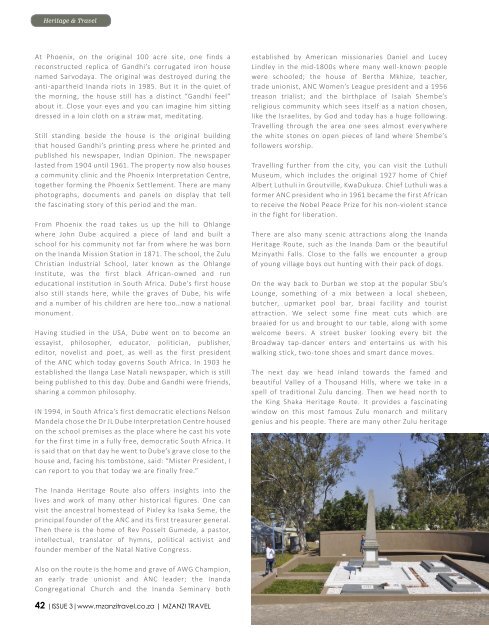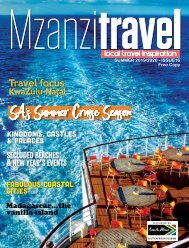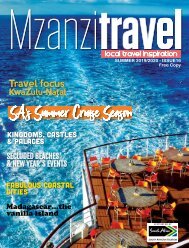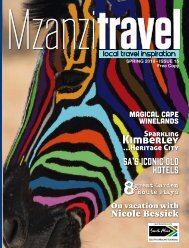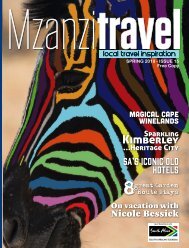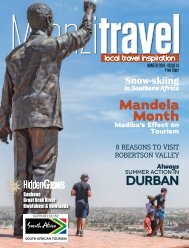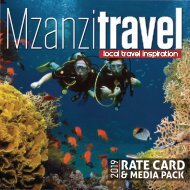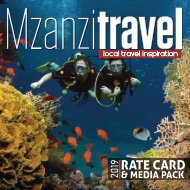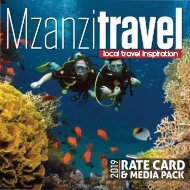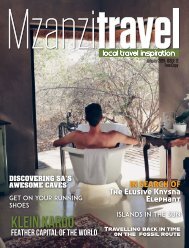MZANZI TRAVEL - ISSUE 3
MZANZI TRAVEL is a glossy, full-colour quarterly, A4 publication that sets out to showcase, foster and promote whatever South Africa has to offer to both local and international tourists.
MZANZI TRAVEL is a glossy, full-colour quarterly, A4 publication
that sets out to showcase, foster and promote whatever South
Africa has to offer to both local and international tourists.
You also want an ePaper? Increase the reach of your titles
YUMPU automatically turns print PDFs into web optimized ePapers that Google loves.
Heritage & Travel<br />
At Phoenix, on the original 100 acre site, one finds a<br />
reconstructed replica of Gandhi’s corrugated iron house<br />
named Sarvodaya. The original was destroyed during the<br />
anti-apartheid Inanda riots in 1985. But it in the quiet of<br />
the morning, the house still has a distinct “Gandhi feel”<br />
about it. Close your eyes and you can imagine him sitting<br />
dressed in a loin cloth on a straw mat, meditating.<br />
Still standing beside the house is the original building<br />
that housed Gandhi’s printing press where he printed and<br />
published his newspaper, Indian Opinion. The newspaper<br />
lasted from 1904 until 1961. The property now also houses<br />
a community clinic and the Phoenix Interpretation Centre,<br />
together forming the Phoenix Settlement. There are many<br />
photographs, documents and panels on display that tell<br />
the fascinating story of this period and the man.<br />
From Phoenix the road takes us up the hill to Ohlange<br />
where John Dube acquired a piece of land and built a<br />
school for his community not far from where he was born<br />
on the Inanda Mission Station in 1871. The school, the Zulu<br />
Christian Industrial School, later known as the Ohlange<br />
Institute, was the first black African-owned and run<br />
educational institution in South Africa. Dube’s first house<br />
also still stands here, while the graves of Dube, his wife<br />
and a number of his children are here too…now a national<br />
monument.<br />
Having studied in the USA, Dube went on to become an<br />
essayist, philosopher, educator, politician, publisher,<br />
editor, novelist and poet, as well as the first president<br />
of the ANC which today governs South Africa. In 1903 he<br />
established the Ilanga Lase Natali newspaper, which is still<br />
being published to this day. Dube and Gandhi were friends,<br />
sharing a common philosophy.<br />
IN 1994, in South Africa’s first democratic elections Nelson<br />
Mandela chose the Dr JL Dube Interpretation Centre housed<br />
on the school premises as the place where he cast his vote<br />
for the first time in a fully free, democratic South Africa. It<br />
is said that on that day he went to Dube’s grave close to the<br />
house and, facing his tombstone, said: “Mister President, I<br />
can report to you that today we are finally free.”<br />
established by American missionaries Daniel and Lucey<br />
Lindley in the mid-1800s where many well-known people<br />
were schooled; the house of Bertha Mkhize, teacher,<br />
trade unionist, ANC Women’s League president and a 1956<br />
treason trialist; and the birthplace of Isaiah Shembe’s<br />
religious community which sees itself as a nation chosen,<br />
like the Israelites, by God and today has a huge following.<br />
Travelling through the area one sees almost everywhere<br />
the white stones on open pieces of land where Shembe’s<br />
followers worship.<br />
Travelling further from the city, you can visit the Luthuli<br />
Museum, which includes the original 1927 home of Chief<br />
Albert Luthuli in Groutville, KwaDukuza. Chief Luthuli was a<br />
former ANC president who in 1961 became the first African<br />
to receive the Nobel Peace Prize for his non-violent stance<br />
in the fight for liberation.<br />
There are also many scenic attractions along the Inanda<br />
Heritage Route, such as the Inanda Dam or the beautiful<br />
Mzinyathi Falls. Close to the falls we encounter a group<br />
of young village boys out hunting with their pack of dogs.<br />
On the way back to Durban we stop at the popular Sbu’s<br />
Lounge, something of a mix between a local shebeen,<br />
butcher, upmarket pool bar, braai facility and tourist<br />
attraction. We select some fine meat cuts which are<br />
braaied for us and brought to our table, along with some<br />
welcome beers. A street busker looking every bit the<br />
Broadway tap-dancer enters and entertains us with his<br />
walking stick, two-tone shoes and smart dance moves.<br />
The next day we head inland towards the famed and<br />
beautiful Valley of a Thousand Hills, where we take in a<br />
spell of traditional Zulu dancing. Then we head north to<br />
the King Shaka Heritage Route. It provides a fascinating<br />
window on this most famous Zulu monarch and military<br />
genius and his people. There are many other Zulu heritage<br />
The Inanda Heritage Route also offers insights into the<br />
lives and work of many other historical figures. One can<br />
visit the ancestral homestead of Pixley ka Isaka Seme, the<br />
principal founder of the ANC and its first treasurer general.<br />
Then there is the home of Rev Posselt Gumede, a pastor,<br />
intellectual, translator of hymns, political activist and<br />
founder member of the Natal Native Congress.<br />
Also on the route is the home and grave of AWG Champion,<br />
an early trade unionist and ANC leader; the Inanda<br />
Congregational Church and the Inanda Seminary both<br />
42 |<strong>ISSUE</strong> 3|www.mzanzitravel.co.za | <strong>MZANZI</strong> <strong>TRAVEL</strong>


